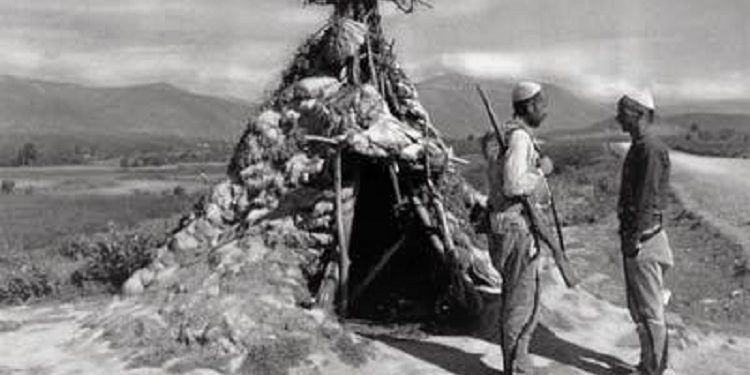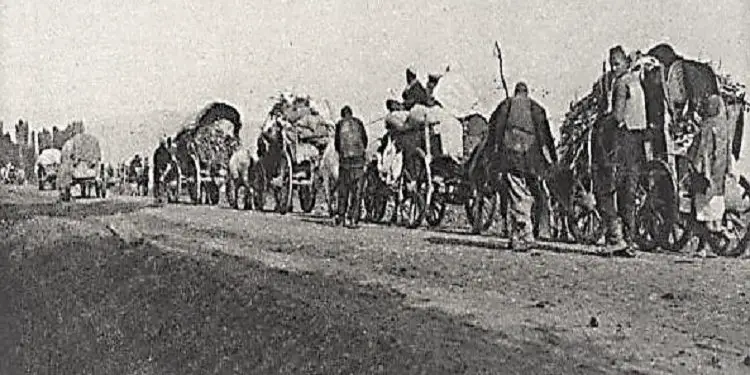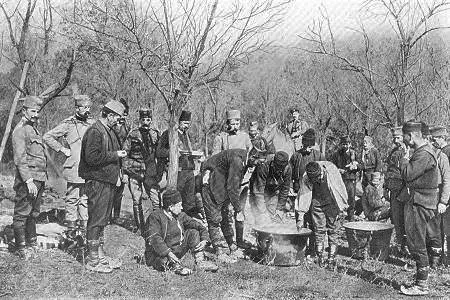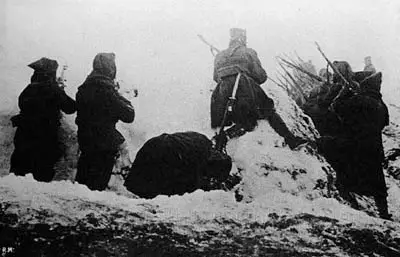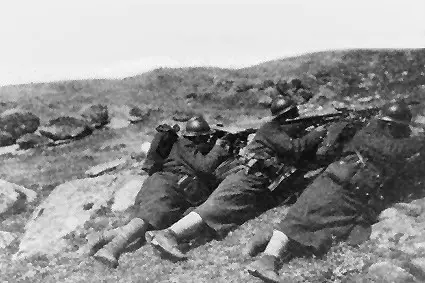From Bashkim Trenova
The seventh part
ALBANIANS ACCORDING TO THE SERBS
(EASTERN CRISIS AND BALKAN WARS)
Memorie.al / “Serbs descend from Slavic tribes, a large number of which gave life to the Slavic people. Knowledge about the origins of the history of the Slavs is modest and not so clear. Their name appears for the first time in the 6th century AD, when Byzantine writers start talking about the Slavs….”! (Dushan Bataković, Milan St. Protic, Nikola Samardžić, Aleksandër Fotic. History of the Serbian People. L’Age d’Homme. Lausanne. 2005. Pg. 3.)
Continues from last issue
INSTEAD OF THE PROLOGUE – A PROJECT, TWO MEMORANDA AND AN ANALYSIS
The Project or Nacertania of Ilia Garasanin – politician, prime minister of Serbia during the years 1852-1853 and 1861-1886:
MYTH-MYSTICISM, VICTIMOMANIA, RACISM AND SERBONOSTALGIA
Dimitrije Bogdanović – historian and member of the Serbian Academy of Sciences and Arts:
The history of Serbian-Albanian relations is one of the forbidden topics. Instead of the racist images of these relations, characterized by three centuries of Albanian rule, we are offered the formula of “shared responsibility”, according to which the function of a twenty-year “Serbian oppression” has the same weight as the oppression exercised over two hundred years the Serbian people….Kosovo is a symbol that reveals deeper processes, decisive for the Serbian people, but not for the Albanian nation. It is about the same thing as in 1389, in Kosovo, about a decisive war.
…Kosovo is a Serbian country since the era of the Great Migrations, since the 7th century. But this historical fact, supported by numerous sources and by archaeological, linguistic and anthropogeographical evidence, is opposed today by the thesis – actually racist – of the Illyrian origin of the Albanians, with the aim of establishing a primary right of the Albanian people over the territories inhabited by Serbs. The ethnogenesis of the Albanians is one of the darkest problems of European prehistory……On the other hand, the prehistory of the Albanians continues until the XI century, the era in which they are mentioned for the first time by historical sources. Until the 13th century, the Albanians did not present a well-defined historical data: they were a nomadic herding people, living in the mountains, without contact with the sea and without a defined ethnic identity… In accordance with the medieval concepts of the State, which did not has never been national in the meaning given to this word today; the Serbian emperor Dushan (1331-1353) received the title of “emperor of the Serbs, Greeks and Albanians”. (1)
1- Boshko I. Bojovic. Le drame youugoslave: Une épreuve manquée de l’Europe. (Yugoslav drama: A missing confrontation of Europe). Printemps, No. 6/1993. Page 124.
***
The Battle of Kosovo (June 15, 1389), in terms of historical importance and the place it has occupied in popular memory, is counted among the biggest armed clashes in European history, such as the battle of Kulikova (1380) or that of Poitie (732). , or even further, in an even more distant past, that of Thermopylae (480 BC). The strong hold that the Serbs made against the Ottoman invasion was broken on the battlefield, but the death of Prince Lazar took the place in the popular consciousness of the symbol of a martyr who suffered for the “kingdom of heaven”, for a spiritual victory, a sacrifice heroically dedicated to civilization. Christians. For the Serbian people, Kosovo is the seal of their identity, the key that allows them to fully understand the message of their history…
…Under the rule of Byzantium until the final integration into the Serbian state of the Njemaničs at the beginning of the 13th century, Kosovo was ethnically a Serbian country….Nomadic groups of cattle breeders of Albanian ethnicity constituted a negligible percentage of the total population, about 2 %, and this mainly in the western parts of the region, in the mountains of today’s Albanian-Yugoslav border area. There were also a small number of Albanian artisans and merchants in the cities. (2) the genocide against the Serbian people is reflected in numerous documents, in the complaints of Christians addressed to the Turkish administration, where the crimes of the Albanians are denounced… The tyranny of the Muslim Albanians extended over the entire territory, from Sanjak to Macedonia and from Metohija to Morava in south (1)
1 – Dimitrije Bogdanovic. La question du Kosovo hier et aujourd’hui. (The issue of Kosovo yesterday and today). Revue des Etudes Slaves. 1984 (56-3). Pg. 387-388.
2 – Right there. Pg. 389.
***
…There is an authentic and precise documentation regarding the crimes committed against the Serbian people in the province of Kosovo. It is only about murder, robbery, rape of churches and cemeteries, rape and kidnapping of young women and girls, even minors, attacks, looting and banditry…….Albanian movements directed against Turkey-especially after cutting ties with the revolution of the Young Turks (1908-1912) – would threaten the vital interests of the Serbian people, even its very existence…
…in 1912…on the southern borders of Serbia, a new state was born, aggressively anti-Serbian from the beginning…(2)
—
…historical sources do not mention the Albanians before the 11th century, their origin and development up to that time thus belong to prehistory; and secondly, the Albanian language occupies a completely unique position in the large family of Indo-European languages – it has no relatives. As a result, the issue of the ethnogenesis of Albanians avoids not only historiographical methods, but also linguistic ones.
…..
As for Illyrianism in the Balkans, it has an older history and a wider cultural and national space than the latter; Albanian Illyrianism, the name Illyrian was used for the South Slavic and Slovene and Croatian peoples – from the 15th century [“natio illyrisa”), therefore the Slavic language was also called “Illyrian language”.
1 – Dimitrije Bogdanovic. La question du Kosovo hier et aujourd’hui. (The issue of Kosovo yesterday and today). Revue des Etudes Slaves. 1984 (56-3). Pg. 392.
2 – Right there. Pg. 392-393.
…
“Illyrianism” in the Balkans is thus a distant fictitious historical argument – from baroque historiography to national romanticism. Albanian “Illyrianism”, at least at first sight, for some ethnogenetic reasons, comes quite late, even anachronistically, in our century.
… The arrival of the Slavs in the Balkan Peninsula and their settlement in a wide area that stretches from the Adriatic to the Black Sea and from the Aegean Sea to the Danube is much better known than the prehistory of the Albanians.
It is not clear whether the Serbs came into contact with the Albanians or with the ethnic ancestors of the Albanians, but something else is clear: this contact did not have a conflict character. The Serbs did not take the land from the Albanians, let alone the state, because it is certain that at the time of the Serbian emigration to the Balkans and long after, there was no state of the Albanian people and no group of Albanians or Albanian ancestors as a historical factor.
…Kosovo and Metohija and other areas on Serbia’s eastern and southern borders, including Byzantine Macedonia, are part of the Serbian state of Nemanjic, an ethnic Serb country. Consequently, they were not only immediately and completely integrated politically, economically and culturally, but immediately after the annexation they also became the central area of all Serbian spiritual and national life in general, a safe basis for the continuation of the unification and completion of the Serbian national territory.
…The importance of Skanderbeg’s endurance is not small, but it should not be overestimated. It represents an honorable and heroic detail of the general Balkan resistance to the Ottoman occupier, in which the Greeks have a place, then the Serbian countries, as well as the non-Balkan forces, which now appear for the first time with more powerful actions against Turkey.
…Judging from all these linguistic and historical data, Kosovo was, in the broadest sense of the word, a Serbian country throughout the 15th century, with a completely Albanian [and even Christian] minority negligible.
…According to its historical importance, the Battle of Kosova is one of the great armed conflicts like the Battle of Kulikova [1380], or the Battle of Poitie [732], or, in an even more distant past, Battle of the Thermopylae Gorge [480. before e.re.]. Each of these struggles is associated with a rich tradition, oral or written literature, moral ideas and messages; each of them is somehow engraved in the national consciousness of the peoples who led that battle and who preserve its memory. Of course, Serbia’s determined resistance to the Ottoman occupation was broken on the battlefield in military and physical terms, but the death of Prince Lazar and the loss of his army won martyrdom for the “kingdom of heaven” in the historical consciousness of the people, therefore, and spiritual triumph in relation to the ideal of Christian civilization. … : the heroism and moral triumph of the victim, refusing submission. For the Serbian people, Kosovo is therefore a confirmation and a trace of their identity, a key that allows them to understand the message of their history,…
…The Peace of Belgrade of 1739 left the Serbian people at the mercy of the Turks and, this time, the Albanian Catholic people as well…. The Serbian regions, from which the Austrian army was retreating, were first looted and burned. This was done by the Muslim Turks and Albanians, the biggest enemies of the Christians… How many Serbs emigrated from old Serbia and from other countries on this occasion in this “second migration”, under Arsenij IV Jovanović, is not known. It is only known that a number of Catholic Albanian families from the Klimenti tribe have arrived in Srem together with the Serbian people. Today, their descendants are part of the Croatian nationality in the villages of Nikinci, Hrtkovci and Jarak.
…The conflict between the Albanian and Serbian people is not, in fact, necessarily a national conflict: these two ethnic groups lived together without any general conflict during many centuries of the Middle Ages. The conflict arose with the religious and social changes under the Turkish and Ottoman feudal order.
…Islamized Albanians became the most powerful and cruel tool of Islamization and conquest of the Christian paradise.
…The consequence of Islamization, as a rule, in the entire area of Albanian expansion in the 17th and 18th centuries, and especially later in the 19th century, is the Albanianization of the Serbian population. Accepting the Islamic religion, entering the tribal community, she accepted the Albanian language and customs and lost her nationality. Moreover, as often happens with converts, the act of accepting Islam created a new hostility towards the old environment. The Islamized Serbs and Albanians were then the most combative and striking part of the Albanian nation…..
In Kosovo at the beginning of the 16th century, or later in the 17th century, there were almost no Albanians, not only Muslims but also Christians. The largest number of Albanians emigrated to Kosovo from the middle of the 18th century to the fourth decade of the last century. A decisive imbalance will occur even later, with the arrival and settlement in these regions of Albanian refugees [“muhajirs”] from the liberated parts of Serbia after 1878…
…
The placement of Albanians in Serbian lands from the 17th century until today has left bloody traces of violence in the historical consciousness of the Serbian people. Many legends about mass and individual oppression, robbery, pogrom and expulsion of Serbs from their country are connected with the arrival and presence of Albanian immigrants.
…
The main task of the Albanian settlers was to fight together with the Turkish army against any external and internal danger, to keep the Slavic-Christian population under control and to facilitate the exploitation of this population….(1)
—————————-
1 – Dimitrije Bogdanović: Book about Kosovo. (Book on Kosovo). Srpska Academy of Sciences. – Special editions. – Book DLXVI. – Primljeno na 7. skupu Odeljenja jezika i književnosti, 25. decembra 1984, na ospra prikaza samog autora. — Belgrade, 1986. ***
Dobrica Qosic – academic, politician, writer and political theorist, president of Yugoslavia in 1992-1993, Serbian “father of the nation”:
People who watch television despise us because they are convinced, day after day, that we have committed ethnic cleansing and collective crime against Albanians. This primitive, half-civilized, cunning and cruel people, criminalized by drug trafficking, by work and degrading social position in Europe and America, managed to create, with blood-soaked money, a lobby of power and protection in the most powerful and more civilized. Albanians have returned to a collective feeling these days. At the same time they managed to mobilize America for their national objectives and coordinate with the US imperialist strategy. They are now America’s ground troops for its Balkan targets. (1)
—
Serbs are the last Jews of the 20th century. Our workers, engineers, doctors, experts are exposed to contempt and hatred. We have caused so much suffering to the “poor little Albanians” that we deserve to be exterminated by the democratic and humane world like beasts and allow them to destroy everything we have built in this century… Have Albanian criminals declared themselves victims of the century? Were America’s Jews sold to Albanian drug dealers? (2)
—
…Anti-war demonstrations broke out in Krushevac. Serbian mothers do not give their “children” for freedom, homeland and Kosovo. Should this capitulation rebellion be done, among others, in Krushevac? There, in Kruševac, where Duke Llazar Hrebeljanović
—————————
1 – Dobrica Qosic. Le Temps des serpents-Notes de l’écrivain 1999-2000. (The Time of Serpents-Writer’s Notes 1999-2000). Page 58. See also -Discours de haine en Serbia. (Hate speech in Serbia). Comité d’Helsinki. Pescanik. 20. 04. 2010.
2 – Right there. Pg. 62.
led the army in the Battle of Kosovo six centuries ago? What happened to Serbia that the women of Krushevac are the ones who are rebelling against the defense of Kosovo today? A paradox of history, its negative dialectic, the fall and death of Serbia? (1)
—
….Serbia has become a battlefield of the past and the future; we are under the attack of the archaic barbarism of the Albanians and the technological barbarism of the Americans and Europeans. We are simultaneously attacked by the past of the Balkans and the future of the world. This alliance of archaic barbarism of Albanians and the techno-electronic barbarism of the Americans is the first alliance of this magnitude on European soil and perhaps the first on our planet. And this alliance has been legitimized through the fight for “human rights” and for the “protection of minorities”. “Protection of minorities”, “prevention of humanitarian disasters” has become in our time the biggest and most monstrous fraud on the part of the big “protectors”, actually the slavers. (2)
—
To Australians, as well as to the entire Western world, we Serbs are nothing but murderers and criminals. And the Albanians, this Balkan tribe, which throughout its existence has not created anything of value for the culture and civilization of the world, which has made a name for itself through the smuggling of narcotics, today represents the most famous victim on the planet. (3)
———————
1 – Dobrica Qosic. Le Temps des serpents-Notes de l’écrivain 1999-2000. (Time of Serpents-Writer’s Notes). Page 109. See also -Discours de haine en Serbia. (Hate speech in Serbia). Comité d’Helsinki. Pescanik. 20. 04. 2010.
2 – Right there. Pg. 118.
3 – Right there. Pg. 150.
—
After the “Agreement of Kumanova”, hordes of murderers, arsonists and robbers penetrated from Albania, plundered and continue to take revenge for the Albanians like wild animals. Churches are burned and looted wherever Serbian madmen have damaged or destroyed their mosques. Revenge is manifold. There is also security from KFOR for Serbs, but it is insufficient, given the extent of Albanian looting, in which children also participate. Those Serbs who dare to return are killed and massacred. Albanians also kill patients lying in bed. There is no one to bury dead Serbian men and women. The corpses rot in the burnt houses and in the canals. If the Serbs, as a peaceful and honorable people, have spared some Albanians from Peja, there are no peaceful and honorable Serbs for the Albanians. For them, all Serbs are blood enemies and everything that is Serbian must disappear. (1)
—
Massacres and torture, looting, burning and killing of Serbs by hordes of Albanians are Asian beasts. I don’t know if there were so many massacres of this kind in the time of Turkey. It is exactly this kind of “humanitarian disaster” that the West turns a blind eye to. The Hague court deals with the “mass graves” of Albanians killed by the Serbs. This corrupt, cynical and thug West allowed Albanians to commit genocidal crimes by opening the border with Albania. NATO, America and the European Union are simulating the creation of “multi-ethnic Kosovo” by allowing genocide against Serbs…(2)
1 – Dobrica Qosic. Le Temps des serpents-Notes de l’écrivain 1999-2000. (Time of Snakes – Writer’s Notes). Pg. 186. See also -Discours de haine en Serbia. (Hate speech in Serbia). Comité d’Helsinki. Pescanik. 20. 04. 2010.
2 – Right there. Pg. 188-189./Memorie.al




